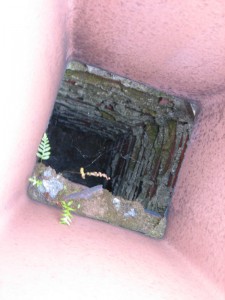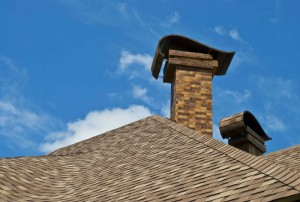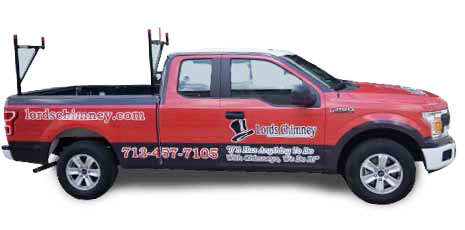Many homeowners pay little attention to their chimney flue. As it is not easily accessible or visible, most do not pay it a second thought. Because of this, many people are shocked to learn that their flue has been cracked or damaged. Likewise, the idea of having a chimney completely relined can seem daunting to many homeowners.
Having your chimney relined with HeatShield is an excellent way to restore the integrity of your chimney flue without the construction of a full flue replacement. Before you go through the time, cost, and mess of having your flue tiles removed and replaced, consider relining your chimney with HeatShield products!

What is HeatShield?
The average person has most likely never heard of HeatShield. Despite its relative lack of name recognition, it is one of the most innovative products for fireplaces and chimneys on the market today.
HeatShield is a specially formulated sealant that can withstand the high heat of the flue, preventing heat, sparks, embers, and dangerous gasses from entering the home. By coating the inside of the flue, HeatShield is able to eliminate the risks created by a cracked or damaged tile flue.
In addition to eliminating the need reline your chimney, our HeatShield products are environmentally friendly, made entirely of naturally-occurring and recycled materials. To give homeowners additional peace of mind, they also come with a 20 year limited warranty.
What HeatShield methods are available?
At Lord’s Chimney, we offer two HeatShield methods to homeowners. The first is the HeatShield joint repair system. This is ideal for homes that have tile lined flues with defective joints. Using a foam applicator that is custom fitted to your chimney, all gaps are filled with the HeatShield product and smoothed using a blade.
The HeatShield resurfacing method is ideal for homes with extensive cracking or spalling. A tie coat, or primer, is used first to remove any dust. After, a quarter-inch layer of HeatShield is applied to the entire length of the flue.
After applying either HeatShield method, a camera is used to verify that there are no remaining gaps or voids and that the chimney has been completely repaired and restored.
Benefits of a correctly lined chimney
Although it may not seem like much, a correctly installed and undamaged chimney liner can greatly impact chimney performance. The primary purpose of a chimney liner is to protect your chimney structure and the rest of your home from the extreme temperatures created by the fireplace. Likewise, chimney liners are also an essential part of stopping chimney fires from spreading to other parts of the home.
In addition, chimney liners prevent carbon monoxide and other harmful gasses from seeping back into the home. By containing and directing these byproducts of combustion out of the home, the chimney liner does more than just extend the life of your brick and mortar chimney. It also keeps your family safe!
If you have questions about how HeatShield products can be used to repair your damaged flue, contact Lord’s Chimney today!
During the cold winter months, many families use their fireplaces as a gathering place, sitting together and enjoying the warm flames. But even as your fireplace is keeping you warm inside, the cold temperatures and winter weather could be damaging your chimney outside.
Winter weather conditions are notorious for destroying chimneys and causing existing damage to deteriorate even faster. Snow, ice, and freezing rain can wreak havoc on a chimney system, even one that is in seemingly good condition. Because of this, it is extremely important get a chimney sweep and inspection before the weather gets any colder. This ensures that your fireplace and chimney are safe to use and have not been damaged during the past year.

Water damage
The main way that chimneys are damaged during the winter months is due to water damage. If water is able to enter a chimney structure, it can cause a multitude of issues including rusting pieces of the flue to damaging the masonry. Pinpointing how water is entering a chimney can often be difficult as there are many different places that can cause leaks. The trained technicians at Lord’s Chimney are leak resolution experts who can find and fix the water entry before it causes further damage.
Below are three of the most common causes of water entry in a chimney system:
Damaged chimney cap: Chimney caps cover the top of the chimney itself, keeping the water from rain, sleet, and snow from getting into a chimney. Improperly installed, ill-fitting chimney caps, or damaged chimney caps can allow water to enter the fireplace system. Damage to the chimney cap is often difficult to spot because they cannot be seen from the street.
Leaky flashing: Flashing is the metal band that connects the chimney to the roof structure. Nail holes, loose caulking, poor materials, or general wear and tear can all cause flashing to lose its waterproof seal. Damaged flashing can cause damage to both the chimney and the roof, which is why it is vital that it is properly installed and maintained.
Masonry damage: Although bricks are made to be porous, absorbing too much water can be detrimental. During the freeze/thaw cycle, water in the brick expands as it freezes, causing additional cracks and damage. As it thaws, this creates more space for additional water entry and the cycle continues, eventually causing the brick to break apart and crumble.
Preventing chimney damage
The best way to prevent damage to your chimney during the winter months is through preventative maintenance. An annual sweep and inspection allows any issues to be spotted and resolved before they become major problems. This can save both time and money as well as preserve the safety and structure of your safety.
Lord’s chimney can also apply a special waterproofing to bricks and mortar. The ChimneySaver sealant retains the porous quality of the bricks, letting toxic gasses pass through without letting moisture in. ChimneySaver also allows trapped moisture to evaporate, preventing deterioration, freeze/thaw damage, and the need for expensive masonry reconstruction.
If you have questions about the health of your chimney system, need to schedule an annual sweep and inspection, or would like more information on ChimneySaver waterproofing, contact Lord’s Chimney today!
Your chimney and venting system consists of several different components to make it function safely and correctly. One of the most important parts of your chimney system, a chimney cap is needed to protect your chimney from water penetration, animal intrusion, and other things. While chimney caps are not required, we at Lords Chimney strongly recommend your chimney be capped for several essential reasons. As the cost and installation of a chimney cap is relatively inexpensive and can protect you against more expensive repair work, there is no excuse not to have a chimney cap on top of your chimney. We would like to tell you why a chimney cap is such a vitally important part of your chimney system.

A chimney cap protects the interior of your chimney from the elements.
According to EBSCO Research, a chimney cap keeps rain and melted snow from entering your chimney. If you receive a two-inch downpour of rain and have no chimney cap, you can get those two inches of rain water into your chimney. A chimney cap also protects you from wind issues. Persistent drafts can cause frustration and loss of money on heating bills. While a basic chimney cap will protect you from rain and melted snow, you can find special wind-resistant caps if you have problems with downdrafts in your chimney.
A chimney cap keeps animals from entering your chimney.
Even if you live in a climate with no snow and little rain, you still need a chimney cap to keep birds, squirrels, and raccoons out of your chimney. Many of these animals mistake chimneys for hollow trees and choose a chimney as a safe place to nest. Both the animals and their nesting can be fire hazards. The nests can cause chimney blockages and prevent toxic gases like carbon monoxide from exiting out through the chimney. This causes a risk of carbon monoxide poisoning since the gas is forced back into your home. Additionally, animals can become trapped and possibly die within your chimney, which causes a horrific odor and a possible bug infestation. To prevent these problems that come along with animal invasions. Contact Lords Chimney to install a chimney cap with metal screening on the sides to keep the animals out.
A chimney cap prevents sparks from jumping out of the chimney and igniting a fire.
We have talked about how a chimney cap is needed to keep things out of your chimney, but a cap is also important to keep hot sparks and embers inside your chimney. Occasionally, sparks and embers can fly out of your chimney and land on your roof or your neighbor’s roof, which can possibly cause a house fire. These sparks and embers may also land in your yard on a pile of leaves or a bush and cause a brush fire, which can quickly and easily become out of control. To prevent this, have a chimney cap with spark arrestors, or wire meshing, to keep the hot sparks and embers safely within your chimney.
Have more questions about chimney caps? Contact Lords Chimney to talk to our expert staff about custom installing a chimney cap on top of your chimney.




